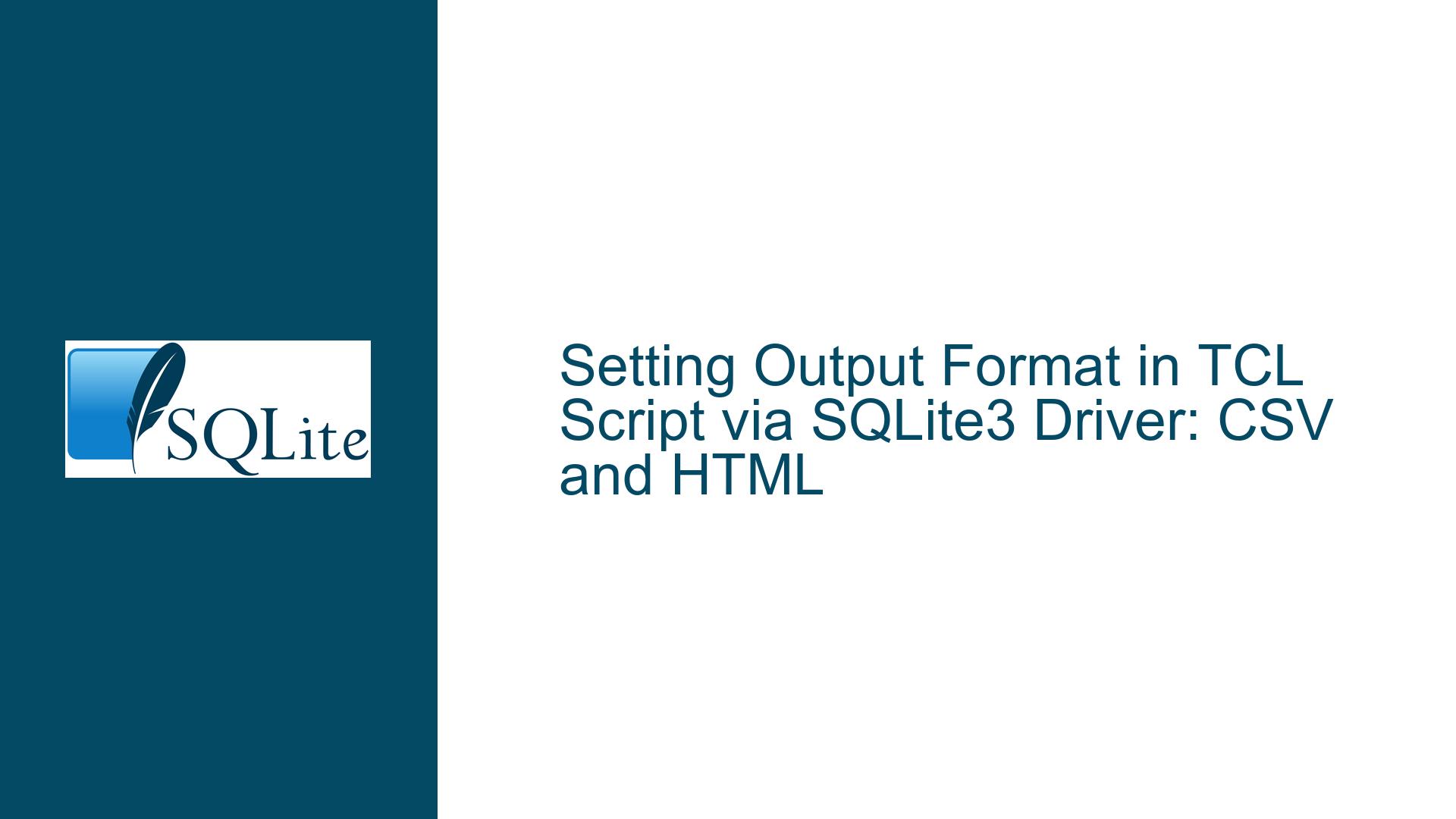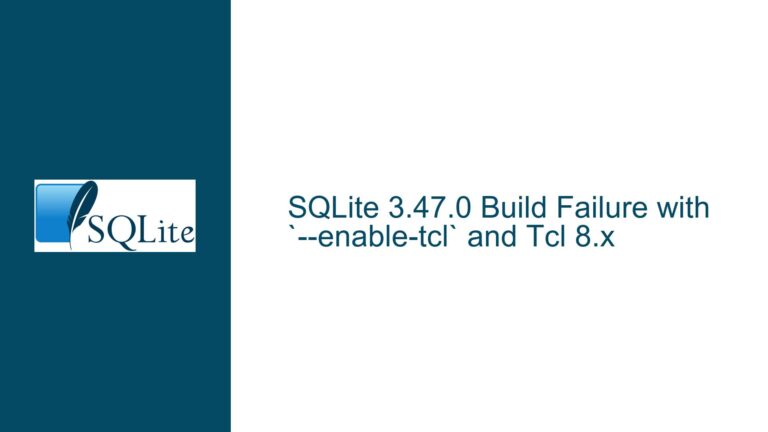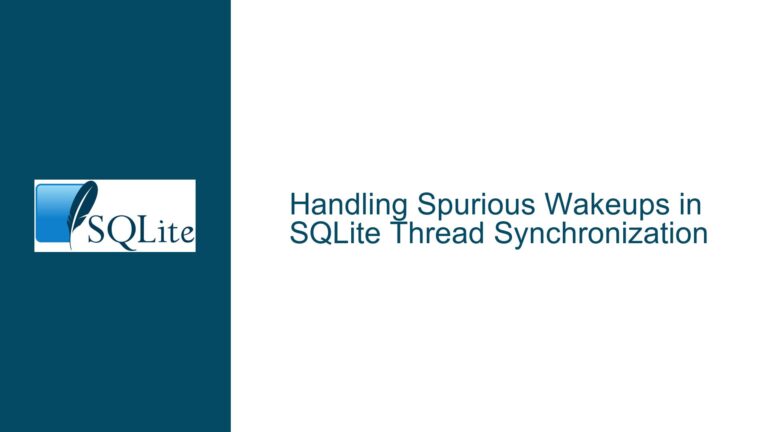Setting Output Format in TCL Script via SQLite3 Driver: CSV and HTML
Understanding the SQLite3 TCL Driver and Output Formatting
The core issue revolves around the inability to use SQLite3’s dot-commands, such as .mode, within a TCL script that interfaces with SQLite3 via the SQLite3 TCL driver. Dot-commands like .mode csv or .mode html are exclusive to the SQLite3 shell and are not part of the SQLite3 library (libsqlite3) itself. This limitation becomes apparent when attempting to format query outputs directly within a TCL script, especially in scenarios like CGI scripts where the output format (e.g., CSV or HTML) is crucial.
The SQLite3 TCL driver provides a mechanism to execute SQL queries and retrieve results, but it does not natively support the dot-commands available in the SQLite3 shell. This means that any formatting of query results must be handled programmatically within the TCL script. The discussion highlights the need for a workaround to achieve CSV or HTML output formatting when using the SQLite3 TCL driver.
Possible Causes of the Output Formatting Limitation
The primary cause of this limitation is the architectural separation between the SQLite3 shell and the SQLite3 library. The SQLite3 shell is a command-line application that provides a user-friendly interface to interact with SQLite databases. It includes a set of dot-commands (e.g., .mode, .headers, .output) that are designed to control the shell’s behavior and output formatting. These dot-commands are implemented within the shell application and are not exposed through the SQLite3 library API.
When using the SQLite3 TCL driver, the interaction with the SQLite3 database is mediated through the SQLite3 library, which does not include the dot-commands. As a result, any attempt to use dot-commands like .mode csv within a TCL script will fail, as these commands are not recognized by the SQLite3 library. This architectural decision ensures that the SQLite3 library remains lightweight and focused on core database functionality, leaving output formatting to the application layer.
Another contributing factor is the lack of built-in support for output formatting in the SQLite3 TCL driver. While the driver provides methods to execute SQL queries and retrieve results, it does not include utilities for formatting these results into specific output formats like CSV or HTML. This places the burden of output formatting on the developer, who must implement the necessary logic within their TCL script.
Troubleshooting Steps, Solutions, and Fixes for Output Formatting
To address the issue of output formatting in a TCL script using the SQLite3 driver, several approaches can be taken. These approaches range from leveraging external tools and libraries to implementing custom formatting logic within the TCL script.
1. Using External Tools for Output Formatting
One straightforward solution is to use external tools to handle the output formatting. This approach involves invoking the SQLite3 shell from within the TCL script using the exec command. By doing so, the TCL script can leverage the dot-commands available in the SQLite3 shell to format the query output.
For example, to generate CSV output, the TCL script can execute the following command:
set rst [exec echo "select * from test;" | sqlite3 -csv ./data.db]
In this example, the exec command is used to invoke the SQLite3 shell with the -csv option, which instructs the shell to output the query results in CSV format. The query results are then captured in the rst variable for further processing or output.
While this approach is simple and effective, it has some drawbacks. It relies on the availability of the SQLite3 shell on the system, which may not always be the case. Additionally, invoking an external process introduces overhead and may not be suitable for performance-critical applications.
2. Leveraging TCL Libraries for Output Formatting
Another approach is to use TCL libraries to handle the output formatting. TCL provides several libraries that can be used to generate CSV or HTML output, such as the csv package from Tcllib. By using these libraries, the TCL script can format the query results programmatically without relying on external tools.
For example, to generate CSV output using the csv package, the TCL script can be structured as follows:
package require Tcl 8.6
package require sqlite3
package require csv
sqlite3 db ./data.db
set first true
db eval {select * from test} ary {
if {$first} {
puts [csv::join $ary(*)]
set first false
}
puts [csv::join [lmap key $ary(*) {set ary($key)}]]
}
In this example, the csv::join function is used to format each row of the query results as a CSV string. The lmap command (available in Tcl 8.6 and later) is used to iterate over the keys in the ary array and construct a list of values for each row. The csv::join function then joins these values into a CSV-formatted string, which is printed to the standard output.
For older versions of Tcl (e.g., Tcl 8.5), the lmap command is not available, and an alternative approach using foreach can be used:
package require sqlite3
package require csv
sqlite3 db ./data.db
set first true
db eval {select * from test} ary {
if {$first} {
puts [csv::join $ary(*)]
set first false
}
set row {}
foreach key $ary(*) {
lappend row $ary($key)
}
puts [csv::join $row]
}
In this version, the foreach command is used to iterate over the keys in the ary array and construct a list of values for each row. The csv::join function is then used to format the row as a CSV string.
3. Implementing Custom Formatting Logic
In cases where specific formatting requirements cannot be met by existing libraries, custom formatting logic can be implemented within the TCL script. This approach provides the greatest flexibility but requires more effort to implement and maintain.
For example, to generate HTML output, the TCL script can be structured as follows:
package require sqlite3
sqlite3 db ./data.db
puts "<html>"
puts "<body>"
puts "<table border='1'>"
db eval {select * from test} ary {
puts "<tr>"
foreach key $ary(*) {
puts "<td>$ary($key)</td>"
}
puts "</tr>"
}
puts "</table>"
puts "</body>"
puts "</html>"
In this example, the TCL script generates an HTML table by iterating over the query results and constructing HTML tags for each row and cell. The resulting HTML is printed to the standard output, which can be redirected to a file or sent as part of a CGI response.
4. Using Wapp for Integrated Web Applications
For more complex web applications, the Wapp framework can be used to integrate SQLite3 and Tcl in a seamless manner. Wapp is a lightweight web application framework that is designed to work with SQLite3 and Tcl. It provides a simple and consistent API for building web applications, including support for output formatting.
To use Wapp, the TCL script must be structured as a Wapp application. The following example demonstrates how to generate CSV output using Wapp:
package require wapp
wapp-start {
wapp-subst {
<html>
<body>
<pre>
}
sqlite3 db ./data.db
set first true
db eval {select * from test} ary {
if {$first} {
wapp-subst [csv::join $ary(*)]
set first false
}
wapp-subst [csv::join [lmap key $ary(*) {set ary($key)}]]
}
wapp-subst {
</pre>
</body>
</html>
}
}
In this example, the wapp-subst command is used to generate HTML output, with the query results formatted as CSV within a <pre> tag. The Wapp framework handles the HTTP response, making it easy to build web applications that interact with SQLite3 databases.
Conclusion
The inability to use SQLite3 dot-commands like .mode within a TCL script is a limitation imposed by the separation between the SQLite3 shell and the SQLite3 library. To achieve output formatting in CSV or HTML, developers can use external tools, leverage TCL libraries, implement custom formatting logic, or use the Wapp framework for integrated web applications. Each approach has its advantages and trade-offs, and the choice of method depends on the specific requirements of the application. By understanding these options, developers can effectively format query results in TCL scripts that interact with SQLite3 databases.





